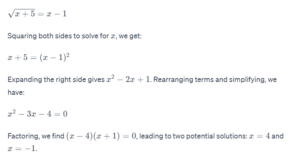Explore the definition, meaning, and examples of extraneous solutions in equations. Discover what makes a solution extraneous and gain a clear understanding with our expert insights.
If you’re searching for the extraneous solutions definition or want to know what sets them apart, delve into our guide for a comprehensive overview. Learn more about extraneous solution meaning and the process of identifying and handling them in mathematical equations. Elevate your understanding today!
In mathematics, a solution to an equation is a value or set of values that make the equation true when substituted into it. Equations typically involve variables, and finding solutions involves determining the values for which the equation holds true.
For example, in the equation 2x−5=3, the solution is x=4, because substituting x=4 into the equation results in a true statement: 2(4)−5=3.
What is an Extraneous Solution?
An extraneous solution, in the context of solving equations, refers to a solution that, upon closer examination, does not satisfy the original equation. It’s crucial to differentiate between valid solutions and extraneous solutions to ensure the accuracy of mathematical conclusions.
Defining Extraneous Solutions:
To grasp the concept better, let’s break down the definition of extraneous solutions. When we solve an equation, we are essentially seeking values that make both sides of the equation equal. However, in some cases, solutions may emerge that, when plugged back into the original equation, fail to satisfy it. These solutions are labeled as extraneous.
Common Scenarios Leading to Extraneous Solutions:
1. Radicals and Denominators:
Extraneous solutions often rear their heads when dealing with radicals or variables in the denominator. Square roots, for example, may introduce solutions that, when squared, lead to extraneous values.
2. Multiplication and Division:
Multiplying or dividing both sides of an equation can sometimes introduce extraneous solutions, especially when operations involve variables in the denominator.
How to Identify Extraneous Solutions:
1. Check All Solutions:
After obtaining potential solutions, to Identify Extraneous Solutions it’s crucial to check them by plugging them back into the original equation. Solutions that satisfy the original equation are valid, while those that don’t are extraneous.
2. Examine Both Sides:
A vigilant examination of both sides of the equation during the solving process can help anticipate potential extraneous solutions.
Extraneous Solution Example
Example 1: Quadratic Equation
Consider the quadratic equation:
The left-hand side equals zero, confirming that is a valid solution. There are no extraneous solutions in this case.
Example 2: Square Root Equation
Now, let’s examine an equation involving square roots:

However, we must check these solutions by plugging them back into the original square root equation:
This solution is extraneous as the left side does not equal the right side.
Therefore, in this example, is the extraneous solution, and is the valid solution.
These examples showcase the importance of checking solutions to ensure they satisfy the original equation and help identify extraneous solutions in the process.
FAQs About Extraneous Solutions:
Q1: What is a simple extraneous solution example?
A simple example involves solving an equation with a square root. If the solution includes a negative value, it may turn out to be extraneous.
Q2: What is the difference between no solution and extraneous solution?
While no solution implies that there are no valid solutions, an extraneous solution suggests the presence of seemingly valid solutions that, upon verification, do not satisfy the original equation.
Q3: When should you check for extraneous solutions?
It is advisable to check for extraneous solutions whenever dealing with equations involving radicals, variables in the denominator, or complex operations like multiplication and division.
Q4: What is an extraneous solution quizlet?
A quizlet on extraneous solutions typically covers definitions, examples, and the process of identifying and handling extraneous solutions in equations.
Conclusion:
Understanding extraneous solutions is pivotal in the realm of equation-solving. By delving into their definition, meaning, and examples, mathematicians can navigate the intricate landscape of mathematical problem-solving with greater precision. Always remember to check all solutions and scrutinize each step, ensuring the validity of your mathematical conclusions.









